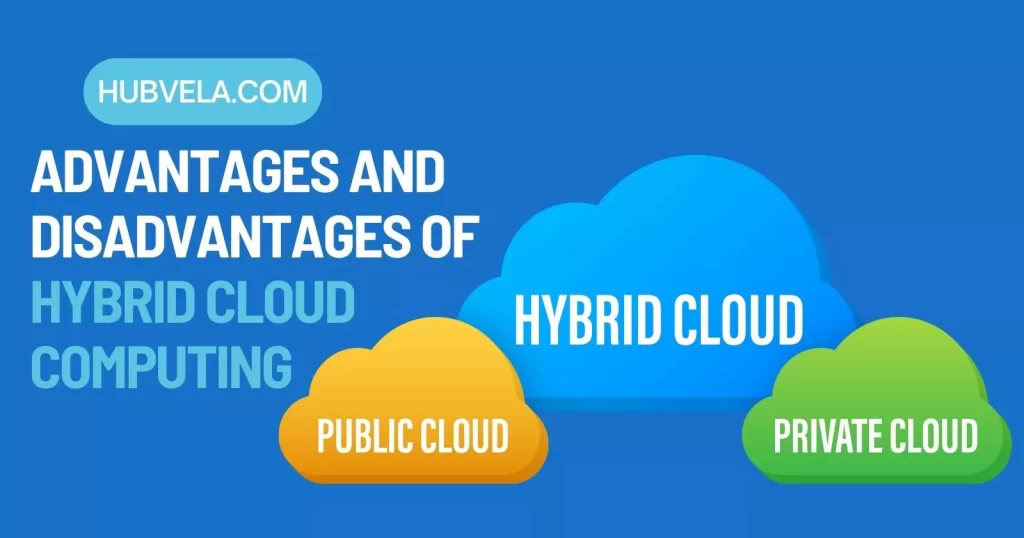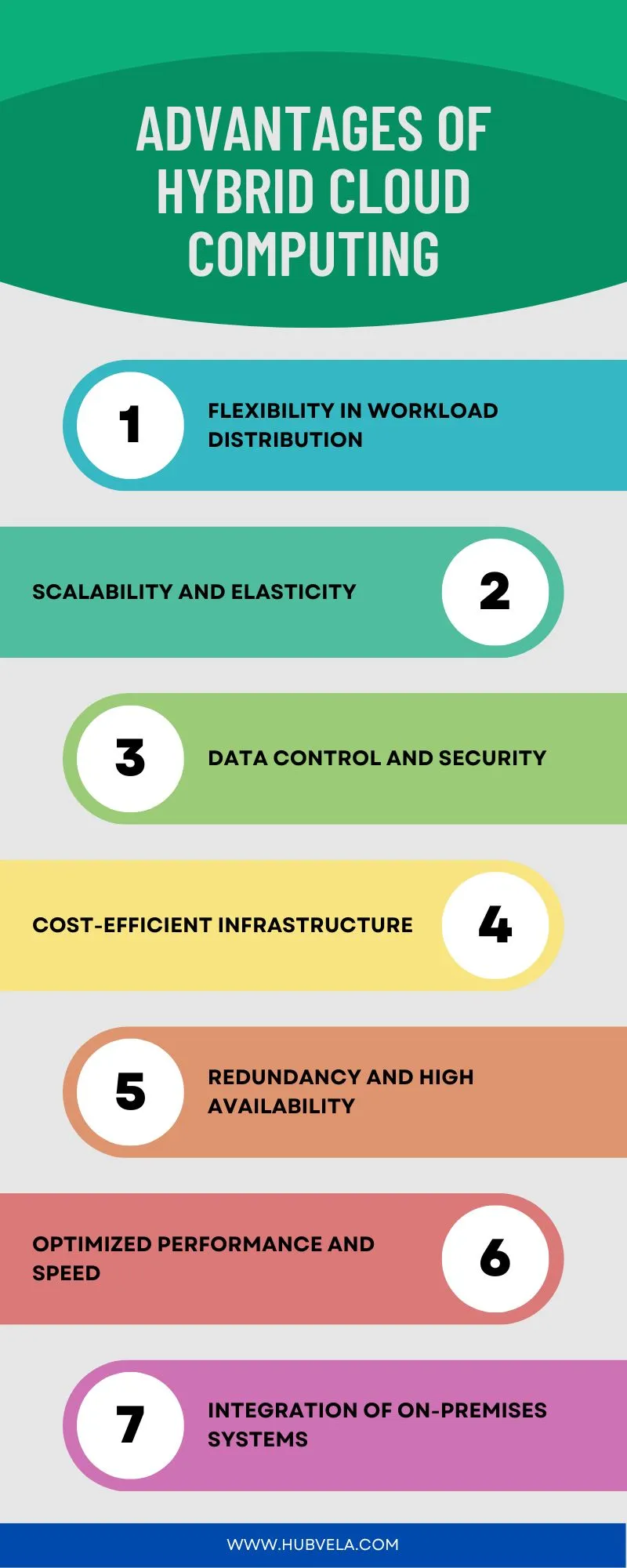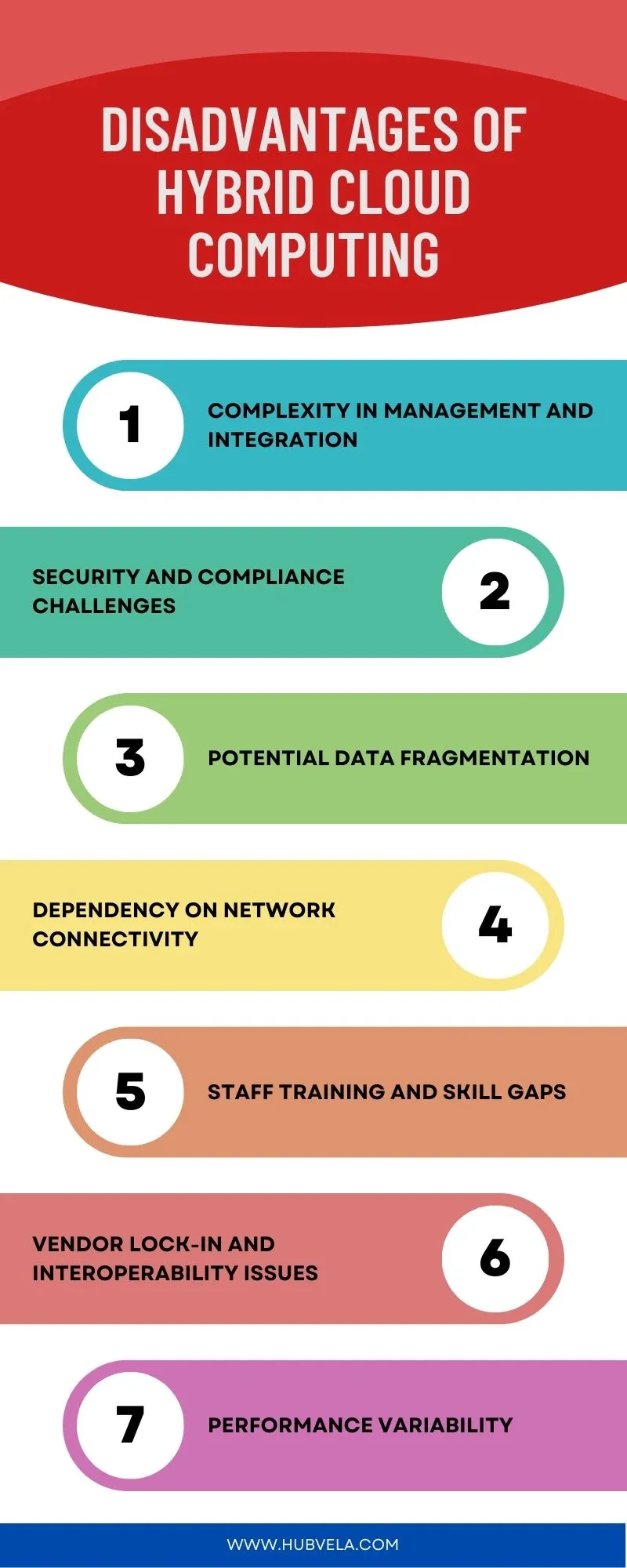Hybrid cloud computing is a mixed computing, storage, and services environment made up of on-premises infrastructure, private cloud services, and a public cloud.
It combines the best features of public and private clouds, making it a key investment for many businesses. However, like any technology, hybrid cloud computing has its advantages and disadvantages.
In this article, we will explore the advantages and disadvantages of hybrid cloud computing to help you decide if it is worth investing in for your organization.

--Advertisement--
Advantages of Hybrid Cloud Computing
Hybrid cloud computing offers several advantages over other cloud or non-cloud-based solutions, including scalability, security, cost, control, and speed. We will explore the advantages of hybrid cloud computing in more detail.

1. Flexibility in Workload Distribution
Flexibility in workload distribution is a key advantage of hybrid cloud computing. Organizations can leverage a hybrid cloud to allocate public cloud resources for short-term projects at a lower cost than using their own data center’s IT infrastructure.
This flexibility allows businesses to support remote and distributed employees with on-demand access to data that isn’t tied to a specific location.
Additionally, a hybrid cloud environment gives businesses greater control over their data, enabling them to scale their workloads according to evolving business needs and fluctuating demand for IT services.
Furthermore, the hybrid cloud allows for increased automation, enabling organizations to adjust their cloud settings to respond automatically to changes in demand, optimizing performance and efficiency.
The flexibility in workload distribution provided by hybrid cloud computing offers enhanced agility, innovation, and control, allowing organizations to customize their IT infrastructure to suit their specific requirements.
2. Scalability and Elasticity
Scalability and elasticity are two important advantages of hybrid cloud computing. Scalability refers to the ability to handle a growing workload where good performance is also needed to work efficiently with existing hardware resources.
It is used to fulfill the static needs of an organization, and customers have to pay per use for this service. Scalability can be achieved through vertical, horizontal, or diagonal scaling.
On the other hand, elasticity is used to meet dynamic changes where the resources needed can increase or decrease. It is used to address the increase in workload in an organization and is used just to meet the sudden ups and downs in the workload for a small period of time.
Elasticity allows businesses to use cloud services for at least some of their IT operations and take advantage of the following cloud computing scalability benefits: cost efficiency, disaster recovery, flexibility and speed, and cost savings.
By implementing elastic scaling rules, businesses can ensure optimal performance and cost efficiency.
3. Data Control and Security
Hybrid cloud computing offers several advantages, including better control over data and improved cloud security, which are essential for organizations.
With a hybrid cloud infrastructure, enterprises can choose where to house their data and workloads based on compliance, policy, or security requirements.
The hybrid environment also lets security teams standardize redundant cloud storage, which is an important aspect of disaster recovery and data insurance.
A hybrid cloud’s centralized management also makes it easier to implement strong technical security measures such as encryption, automation, access control, orchestration, and endpoint security so that organizations can manage risk effectively.
Hybrid cloud computing provides organizations with the flexibility to support their remote and distributed employees with on-demand access to data that isn’t tied to one central location.
4. Cost-Efficient Infrastructure
Hybrid cloud computing offers several advantages, including cost-efficient infrastructure. Hybrid clouds often help lower long-term costs, freeing up some headroom in an organization’s budget.
With a hybrid cloud infrastructure, organizations can move any core or sensitive data to their private on-premise servers while making key applications and services available on the public cloud, accessible from any location with the right credentials.
Hybrid cloud architecture can be composed of several different cloud environment types, including public cloud, on-premises private cloud, and others.
The hybrid approach allows applications and components to interoperate across boundaries, between cloud instances, and even between architectures, providing the same level of distribution and access flexibility for data.
5. Redundancy and High Availability
Hybrid cloud computing offers several advantages, including redundancy and high availability. By combining public and private cloud resources, organizations can ensure that their data and applications remain accessible even in the event of a failure in one part of the infrastructure.
This redundancy enhances the reliability of the overall system, reducing the risk of downtime and data loss.
Additionally, the hybrid cloud model allows for high availability by enabling organizations to distribute workloads across different cloud environments, ensuring that critical applications and services remain operational even if one part of the infrastructure experiences issues.
This approach enhances resilience and minimizes the impact of potential disruptions, contributing to a more robust and dependable IT environment.
6. Optimized Performance and Speed
Hybrid cloud computing offers several advantages, including optimized performance and speed. By leveraging a hybrid cloud setup, organizations can enhance the speed of their network resources and optimize the data transfer process, ultimately reducing latency.
This is achieved by allowing IT teams to make adjustments to the infrastructure, enabling them to streamline the network and take advantage of edge computing, which can significantly improve the overall speed of the IT infrastructure.
While a hybrid cloud environment may not inherently be quicker than a public or multi-cloud setup, it provides the flexibility to optimize the network, resulting in improved performance and speed.
7. Integration of On-Premises Systems
Hybrid cloud computing offers the advantage of integrating on-premises systems with cloud services, allowing organizations to obtain the “best of both worlds”.
This means that companies can use cloud services where it works best while keeping certain operations within their own on-premises network infrastructure or inside a private cloud, providing greater flexibility.
For example, if one application requires more computing power than another and the on-premises data center has more resources than the cloud side, the company has the freedom to move that operation into its in-house data center—or vice versa.
This integration of on-premises systems with cloud services is one of the key benefits of hybrid cloud computing.
Disadvantages of Hybrid Cloud Computing
There are also several disadvantages to using a hybrid cloud model, including difficulty of implementation, security concerns, and compatibility issues. We will explore the disadvantages of hybrid cloud computing in more detail.

1. Complexity in Management and Integration
Complexity in management and integration is a significant challenge associated with hybrid cloud computing. Managing a hybrid cloud environment requires expertise in both private and public cloud technologies and careful coordination.
Hybrid cloud deployments can introduce complexity and potential bottlenecks because data moves between the private and public clouds.
This complexity extends to security considerations, as data transfers between private and public clouds need to be secure, and access controls must be carefully managed. Meeting regulatory compliance requirements across multiple cloud environments can also be a complex task.
Additionally, organizations need to monitor and optimize resource usage across the hybrid environment to avoid unexpected expenses, as there may be costs associated with data transfers between private and public clouds.
Therefore, while hybrid cloud computing offers various advantages, including scalability, cost management, and control of data, the complexity in managing and integrating the different cloud environments remains a notable disadvantage.
2. Security and Compliance Challenges
One of the main disadvantages of hybrid cloud computing is the security and compliance challenges that come with it. Hybrid cloud computing involves managing data securely across platforms and locations, which can be difficult for businesses.
One of the biggest challenges is maintaining a consistent posture or obtaining overall compliance with hybrid clouds, as comprehensive security risk assessment is a hurdle when evaluating hybrid cloud services.
It can be conducted separately for public and private clouds instead of evaluating it comprehensively as one. Another challenge is the lack of encryption, as a single error in the overall network architecture may lead to the disruption of cloud services.
Misconfigurations can also occur when IT staff are not familiar with the hybrid environment and do not properly configure the security settings.
Compliance issues can arise as well, as the responsibility for security is shared between the organization and the cloud provider, creating complexities in terms of having a clear understanding of the responsibilities of each party.
3. Potential Data Fragmentation
Potential data fragmentation is a disadvantage of hybrid cloud computing. Hybrid cloud computing involves the integration of on-premises hardware with one or more public cloud sites via a Wide Area Network (WAN).
This integration can lead to data fragmentation, where data is spread across multiple locations and becomes difficult to manage. This can result in issues with data consistency, as well as increased complexity in data management and security.
Additionally, data fragmentation can make it more difficult to monitor and maintain visibility into cloud resources, which can lead to security concerns.
To mitigate this disadvantage, organizations need to carefully plan their hybrid cloud strategy and ensure that they have the necessary tools and processes in place to manage data effectively across multiple locations.
4. Dependency on Network Connectivity
Dependency on Network Connectivity is a significant disadvantage of hybrid cloud computing. Since hybrid cloud environments involve the integration of on-premises infrastructure with public and private cloud services, they heavily rely on network connectivity for seamless operation.
Any disruption in network connectivity can lead to challenges in accessing data and applications, affecting the overall performance and productivity of the organization.
This dependency on network connectivity introduces a potential single point of failure, where if the network fails, the entire hybrid cloud infrastructure may become inaccessible, impacting critical business operations.
Therefore, organizations considering hybrid cloud adoption need to carefully assess and ensure robust network connectivity to mitigate this dependency and its associated risks.
5. Staff Training and Skill Gaps
Hybrid cloud computing offers various advantages, such as greater flexibility, cost savings, and scalability. However, it also presents some disadvantages, including staff training and skill gaps.
The complexity of managing dual operations, security, and governance tools across multiple platforms can pose a challenge for staff who may not be familiar with hybrid cloud operations.
This can lead to skill gaps within the organization, requiring additional training and expertise to effectively manage the hybrid cloud environment.
Additionally, the interconnection between public and private clouds in a hybrid environment introduces new security concerns, requiring specialized knowledge in compliance and data security.
Therefore, organizations considering hybrid cloud adoption should be mindful of the potential skill gaps and invest in staff training and cloud certifications to address these challenges effectively.
6. Vendor Lock-In and Interoperability Issues
Vendor lock-in and interoperability issues are significant disadvantages of hybrid cloud computing. Vendor lock-in occurs when a company becomes overly dependent on a single cloud provider, making it challenging to switch platforms without incurring substantial costs, legal constraints, or technical incompatibilities.
This can happen when a customer has invested heavily in a specific cloud platform, making it difficult to transition to another provider without facing significant challenges.
Interoperability issues arise due to the lack of standardization in cloud computing, inhibiting the portability of applications across different cloud service types and deployment models.
This can limit flexibility and hinder the ability to take advantage of the strengths and capabilities of various cloud providers.
To mitigate these issues, organizations can adopt practices such as utilizing standards-based solutions and implementing a hybrid cloud approach, which combines on-premises and multi-cloud environments to increase flexibility and innovation.
7. Performance Variability
One of the disadvantages of hybrid cloud computing is performance variability. Data- and I/O-intensive applications can trigger problems such as network congestion, latency, jitter, packet loss, and excessive bandwidth consumption.
Networking bottlenecks are highly dependent upon the underlying infrastructure and the nature of the packets being sent across the network.
With big data, this can easily become a performance bottleneck. While hybrid clouds can take many forms, there are pros and cons of the hybrid cloud that generally hold true.
Conclusion on Advantages and Disadvantages of Hybrid Cloud Computing
In conclusion, hybrid cloud computing is a mixed computing, storage, and services environment made up of on-premises infrastructure, private cloud services, and a public cloud.
The primary benefit of a hybrid cloud is agility, allowing organizations to combine public clouds, private clouds, and on-premises resources to gain the agility they need for a competitive advantage.
Hybrid cloud computing provides cost savings, increased data security, flexibility, and a unique balance of control, performance, and scalability.
However, the hybrid option can end up being much more expensive than opting for a public cloud model due to the investment in, maintenance of, and expertise needed in both the on-premises hardware and private cloud components.
Ultimately, the decision to adopt a hybrid cloud model depends on an organization’s computing requirements and goals.


